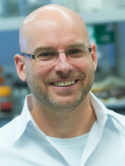Tying synaptonemal complex initiation to the formation and programmed repair of DNA double-strand breaks Journal Article
| Authors: | Henderson, K. A.; Keeney, S. |
| Article Title: | Tying synaptonemal complex initiation to the formation and programmed repair of DNA double-strand breaks |
| Abstract: | During meiosis, homologous chromosomes recombine and become closely apposed along their lengths within the synaptonemal complex (SC). In part because Spo11 is required both to make the double-strand breaks (DSBs) that initiate recombination and to promote normal SC formation in many organisms, it is clear that these two processes are intimately coupled. The molecular nature of this linkage is not well understood, but it has been proposed that SC formation initiates locally at the sites of ongoing recombination and in particular at the subset of sites that will eventually give rise to crossovers. To test this hypothesis, we examined further the relationship between DSBs and SC formation in Saccharomyces cerevisiae. SCs were monitored in a series of spo11 missense mutants with varying DSB frequencies. Alleles that blocked DSB formation gave SC phenotypes indistinguishable from a deletion mutant, and partial loss-of-function mutations with progressively more severe DSB defects caused corresponding defects in SC formation. These results strongly correlate SC formation with Spo11 catalytic activity per se. Numbers of Zip3 complexes on chromosomes, thought to represent the sites of SC initiation, also declined when Spo11 activity decreased, but in a markedly nonlinear fashion: hypomorphic spo11 alleles caused larger defects in DSB formation than in Zip3 complex formation. This nonlinear response of Zip3 closely paralleled the response of crossover recombination products. The quantitative relationship between Zip3 foci, SC formation, and crossing over strongly implicates crossover-designated recombination intermediates as the sites of SC initiation. |
| Keywords: | protein; progression; recombination; saccharomyces-cerevisiae; nodules; yeast meiosis; mouse spermatocytes; wild-type; meiotic chromosome synapsis; spo11 gene; paracentric inversion |
| Journal Title: | Proceedings of the National Academy of Sciences of the United States of America |
| Volume: | 101 |
| Issue: | 13 |
| ISSN: | 0027-8424 |
| Publisher: | National Academy of Sciences |
| Date Published: | 2004-03-30 |
| Start Page: | 4519 |
| End Page: | 4524 |
| Language: | English |
| ACCESSION: | WOS:000220648700036 |
| DOI: | 10.1073/pnas.0400843101 |
| PROVIDER: | wos |
| PMCID: | PMC384779 |
| PUBMED: | 15070750 |
| Notes: | Article -- Source: Wos |
Altmetric
Citation Impact
BMJ Impact Analytics
Related MSK Work





